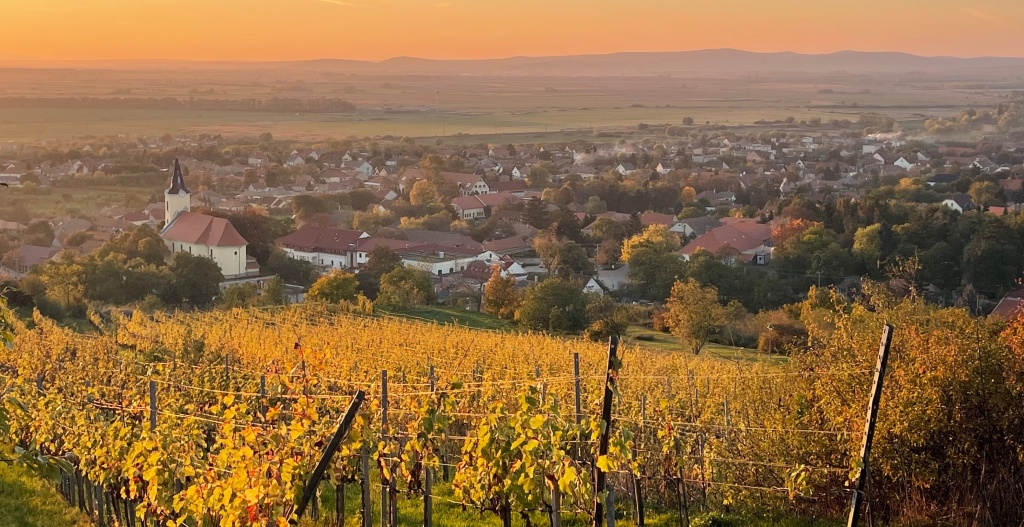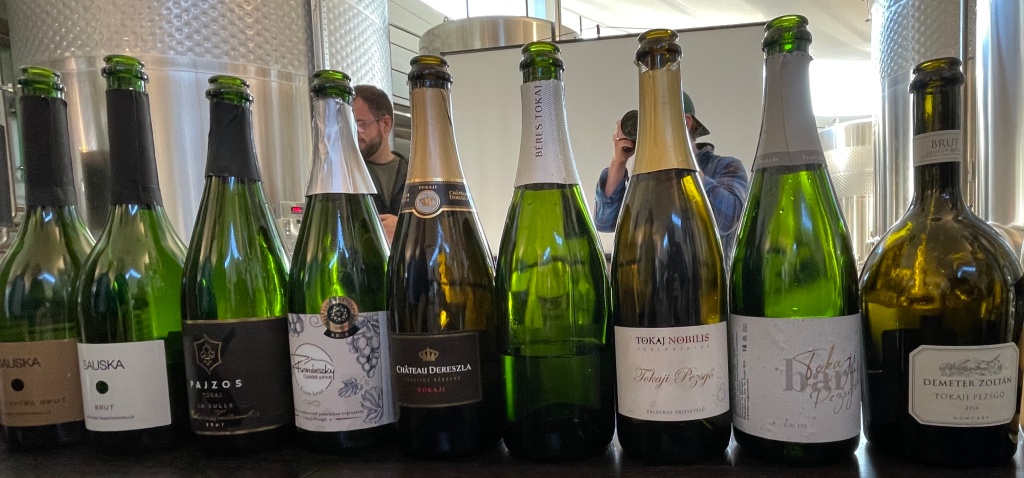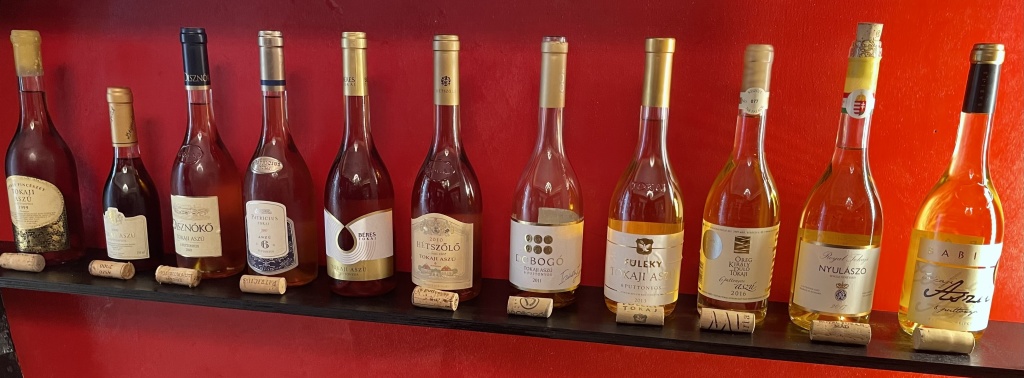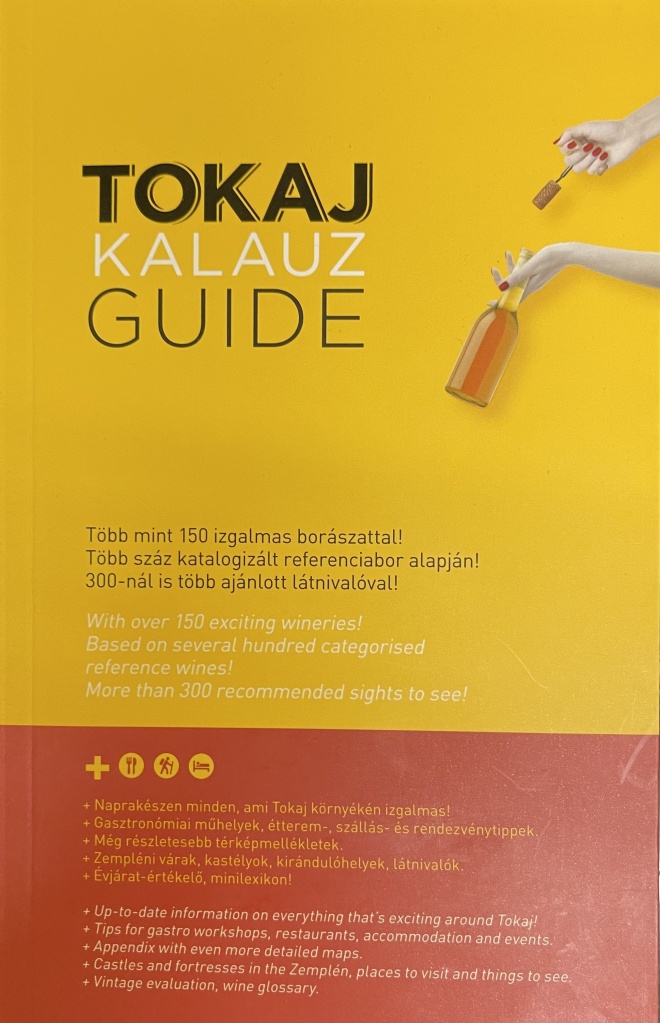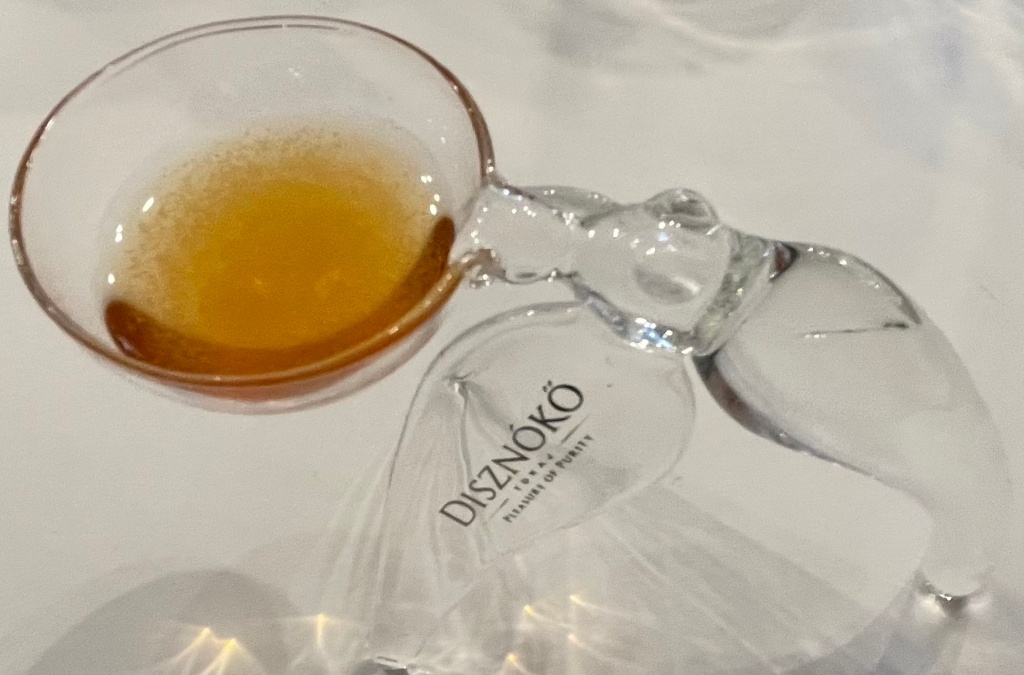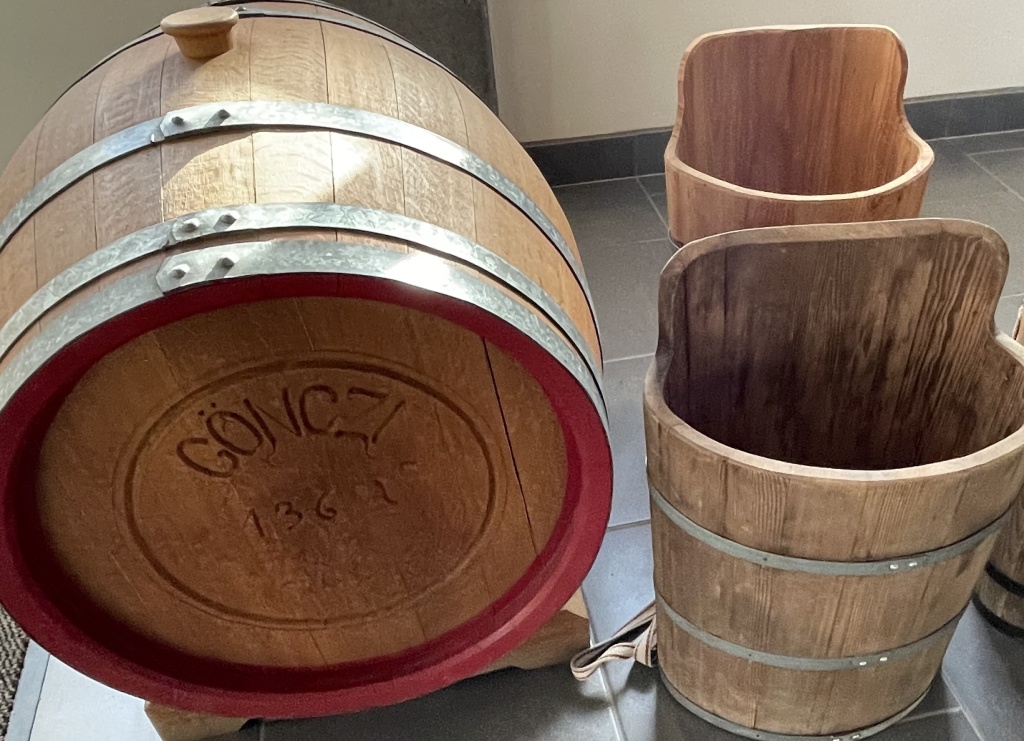The magnificent white wines of the Tokaj region of Hungary are made mainly from three grapes: Furmint, Harslevelu and Yellow Muscat.
About two thirds of the region’s 5,300 total hectares of vines are planted with Furmint. Harslevelu has about 20 percent of plantings and Sargamuskotaly (Yellow Muscat) represents about 10 per cent.
Harslevelu is genetically related to Furmint. Sargamuskotaly is part of the broad Muscat family and has a distinctive floral aroma.
One of the best harselevu I tasted was a 2015 from Kikelet Winery, made by Stéphanie Berecz. Even after I washed my glass with water I could still taste this wonderful wine. More here.
Furmint: The Furmint grape is native to the Tokaj region and was first mentioned in official documents in 1611.
The bulk of the world’s Furmint plantings are in Tokaj but the grape is also grown in the Somlo and Lake Balaton areas of Hungary, and it has migrated to Austria, Croatia, Romania, Slovakia and Slovenia.
Furmint is highly adaptable and makes a range of wine styles. In Tokaj it has traditionally been best known for naturally sweet wines such as Szamorodni (made with whole bunches) and botrytised wines known as aszú (“aszú” is the Hungarian word for what the French call “noble rot”).
Changing styles: In recent years winemakers have also produced dry whites and sparkling styles. Sommelier Gergely Somogyi said these new styles were the result of decreasing interest in sweet wines and thus the need to find new markets. The first sparkling wines made with the grape appeared about a dozen years ago.
The choice of the time to harvest controls the style of wine. Picking at high sugar levels at full ripeness produces a rich and concentrated style in sweet wines and high alcohol levels in dry wines. Sometimes those levels can be too high in dry wines, meaning they taste too hot.
Picking at high levels of acidity at full ripeness produces balanced sweet wines with lashings of flavour. But with dry wines the result can be harsh acidity. Acidity can mean longevity because the acidity helps the ageing process. That is why winemaking is such a challenging balancing act.
When young, Furmint offers aromas of pear and green apple which matures to a bouquet of honey and the petrol aromas associated with old Rieslings. In the mouth young Furmint tastes of apple and/or citrus like grapefruit and lemon. Older wines taste of ripe pear and apple, with honey and nuts appearing in much older wines.
The terroir of Tokaj includes a lot of volcanic rocks which enhance the texture of the wines and provides a mineral or saline flavour in dry wines. The region has a continental climate. Early-morning mists in autumn produce humidity which promotes the noble rot process.
It happens because the Tisza and Bodrog rivers meet in Tokaj. Their waters have slightly different temperatures so mist develops, followed by sunny afternoons that create the perfect environment for botrytis to occur.
Peter Molnar PhD, president of the Council of Tokaj wine communities, said the region was blessed with the right ingredients for great wine. “God was in a good mood when he created the Tokaj region.”
Sparkling wines: Hungary’s sparkling wines are made via the “methode traditional” created in France’s Champagne region, using the three grapes mentioned above. Wines receive a minimum of nine months of bottle ageing and spend a minimum of 90 days on lees. These rules were introduced in 2012 when people started to make sparkling wines in the region.
Regus Camus, chief winemaker of the Piper-Heidsieck house in Champagne, presided over a tasting of sparkling wines at the Sauska Winery in late October 2022. They are shown here.
All wines were well made and fresh with zesty acidity. Indeed, high acidity is a feature of the region’s sparkling wines. Most of the wines were made from 100 per cent Furmint or with this grape the dominant percentage.
Given that most winemakers are new to this style of wine, especially compared with the centuries the Champenois have had to perfect the method, it is difficult to assess the potential for longevity. One point to note is the lack of tertiary flavours of the older wines that we usually associate with autolysis, the process which usually gives wines richness and creaminess as well as aromas of bread, toast or brioche.
Perhaps Furmint-focused sparklers need more time to develop, because the 2016 Demeter Zoltan showed some promise. But it was difficult to detect more than the citrus aromas among the young wines. Vintages tasted ranged from 2020 to 2016.
Some of the wines had almost no residual sugar, which emphasised the acid zing. Regus Camus said sparklers needed some residual sugar to balance the acidity.
But it is the sweet wines that are the crowning glory of the Tokaj region. Below see a row of magnificent wines. Read some of my earlier articles to learn more about the winemaking process.
This trip to Tokaj involved a chance to taste some older vintages – a wonderful experience of going back in time.
When the Grand Tokay 1964 was made the Beatles released their first album in the US, Cassius Clay beat Sonny Liston to become world heavyweight champion, and Dr Martin Luther King was awarded the Nobel Peace Prize.
The wine was like tasting toffee and caramel with a balsamic undercurrent, yet it retained elegant acidity. It was what some people would call a meditation wine.
Laszlo Meszaros, managing director of Disznoko winery, said aszú wine was special because of the balance between sweetness and acidity.
Ripka Gergely, author of the Tokaj Guide, said it was easy to distinguish vintages because “every vintage is unique, with distinctive flavours”. Perhaps three vintages a decade could be considered great, he said.
A highlight was an aszú from 1956. Erzsebet Farkas, export manager at Grand Tokay, said 1956 was a painful year both because of the political events and the fact the harvest was picked late. “People actually picked when it was snowing.”
But they say time heals all concerns. With time this wine has evolved into glory. It has the colour of treacle and aromas of coffee, toffee and nuts with echoes of mushrooms. The acidity still sings and zings, and it still tastes fresh.
What is also remarkable is how the wine evolves in the glass. A second tasting perhaps 15 minutes later offered flavours of zesty bitter almond mixed with figs and nuts. Erzsebet Farkas said the reason the grapes were harvested late was because of the story that everybody rushed to Budapest for the revolution.
I’m not sure if it’s true, but It’s a nice story. Historians will tell you that the Hungarian revolution of 1956 took place between October 23 and November 10 and was a countrywide protest against the government of the Hungarian People’s Republic (1949–1989) and domestic policies imposed by the Soviet Union.
Even more magic was to come with the Grand Tokaj 1947 Esszencia. It was like syrup, a mass of black molasses mixed with mint and menthol, still alive because of the fine backbone of acidity. Think rich Christmas pudding from childhood without the silver coins.
It’s worth noting the number of berries needed to make aszú and esszencia wines. It takes 2.5kg of berries to make one 500ml bottle of Tokaj aszú. But you need 25kg of berries to make one litre of esszencia. It is usually served by the spoonful.
The Grand Tokaj estate makes 5 million bottles a year – 30% sweet and 70% dry. Export manager Erzsebet Farkas said this ratio reflected a growing trend where people preferred dry wines. The company exports 70% of its production. Their biggest markets are the Czech Republic, Poland and Germany.
Measure of sweetness: The traditional way to measure sweetness was based on the number of buckets of aszú berries called puttony (in Hungarian the plural is puttonyos) added to each barrel of wine. Two buckets are shown next to a 136 litre “Göncz” barrel.
Laszlo Meszaros said today the classification was based on residual sugar and all aszú must be at least five puttonyos or 120g/L of residual sugar. Six Puttonyos must be at least 150g/L.
Asked why wines in Tokaj were relatively inexpensive Zoltan Kovacs, managing director of Royal Tokaji, said the rebirth after the Berlin Wall fell had taken time. “We are an old wine region that restarted itself 30 years ago,” he said. “It takes time for prices to increase.”
In 2002 Tokaj received World Heritage status in the “cultural landscape” category. Today almost 5,000 grape growers from the region’s 27 villages are licensed to use the Tokaji name.
At right is an image of what is considered one of the great Tokaj aszú of the past two generations, made by Géza Lenkey.
Make sure you visit the Hercegkút World Heritage cellars. This symbol of the Tokaj region features cellars built from 1750.
They are magic examples of rustic architecture. The village has 200 cellars but only 660 people.
Acknowledgement/disclaimer: Thank you to Wines of Hungary UK who provided air fares, meals and accommodation on my trip to Tokaj in October 2022.
Categories: Uncategorized
